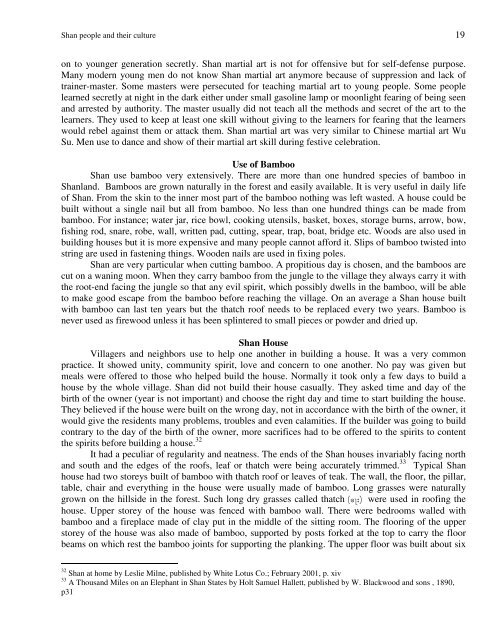History of Shan Churches in Burma 1861-2001 - Khamkoo
History of Shan Churches in Burma 1861-2001 - Khamkoo
History of Shan Churches in Burma 1861-2001 - Khamkoo
Create successful ePaper yourself
Turn your PDF publications into a flip-book with our unique Google optimized e-Paper software.
<strong>Shan</strong> people and their culture 19<br />
on to younger generation secretly. <strong>Shan</strong> martial art is not for <strong>of</strong>fensive but for self-defense purpose.<br />
Many modern young men do not know <strong>Shan</strong> martial art anymore because <strong>of</strong> suppression and lack <strong>of</strong><br />
tra<strong>in</strong>er-master. Some masters were persecuted for teach<strong>in</strong>g martial art to young people. Some people<br />
learned secretly at night <strong>in</strong> the dark either under small gasol<strong>in</strong>e lamp or moonlight fear<strong>in</strong>g <strong>of</strong> be<strong>in</strong>g seen<br />
and arrested by authority. The master usually did not teach all the methods and secret <strong>of</strong> the art to the<br />
learners. They used to keep at least one skill without giv<strong>in</strong>g to the learners for fear<strong>in</strong>g that the learners<br />
would rebel aga<strong>in</strong>st them or attack them. <strong>Shan</strong> martial art was very similar to Ch<strong>in</strong>ese martial art Wu<br />
Su. Men use to dance and show <strong>of</strong> their martial art skill dur<strong>in</strong>g festive celebration.<br />
Use <strong>of</strong> Bamboo<br />
<strong>Shan</strong> use bamboo very extensively. There are more than one hundred species <strong>of</strong> bamboo <strong>in</strong><br />
<strong>Shan</strong>land. Bamboos are grown naturally <strong>in</strong> the forest and easily available. It is very useful <strong>in</strong> daily life<br />
<strong>of</strong> <strong>Shan</strong>. From the sk<strong>in</strong> to the <strong>in</strong>ner most part <strong>of</strong> the bamboo noth<strong>in</strong>g was left wasted. A house could be<br />
built without a s<strong>in</strong>gle nail but all from bamboo. No less than one hundred th<strong>in</strong>gs can be made from<br />
bamboo. For <strong>in</strong>stance; water jar, rice bowl, cook<strong>in</strong>g utensils, basket, boxes, storage burns, arrow, bow,<br />
fish<strong>in</strong>g rod, snare, robe, wall, written pad, cutt<strong>in</strong>g, spear, trap, boat, bridge etc. Woods are also used <strong>in</strong><br />
build<strong>in</strong>g houses but it is more expensive and many people cannot afford it. Slips <strong>of</strong> bamboo twisted <strong>in</strong>to<br />
str<strong>in</strong>g are used <strong>in</strong> fasten<strong>in</strong>g th<strong>in</strong>gs. Wooden nails are used <strong>in</strong> fix<strong>in</strong>g poles.<br />
<strong>Shan</strong> are very particular when cutt<strong>in</strong>g bamboo. A propitious day is chosen, and the bamboos are<br />
cut on a wan<strong>in</strong>g moon. When they carry bamboo from the jungle to the village they always carry it with<br />
the root-end fac<strong>in</strong>g the jungle so that any evil spirit, which possibly dwells <strong>in</strong> the bamboo, will be able<br />
to make good escape from the bamboo before reach<strong>in</strong>g the village. On an average a <strong>Shan</strong> house built<br />
with bamboo can last ten years but the thatch ro<strong>of</strong> needs to be replaced every two years. Bamboo is<br />
never used as firewood unless it has been spl<strong>in</strong>tered to small pieces or powder and dried up.<br />
<strong>Shan</strong> House<br />
Villagers and neighbors use to help one another <strong>in</strong> build<strong>in</strong>g a house. It was a very common<br />
practice. It showed unity, community spirit, love and concern to one another. No pay was given but<br />
meals were <strong>of</strong>fered to those who helped build the house. Normally it took only a few days to build a<br />
house by the whole village. <strong>Shan</strong> did not build their house casually. They asked time and day <strong>of</strong> the<br />
birth <strong>of</strong> the owner (year is not important) and choose the right day and time to start build<strong>in</strong>g the house.<br />
They believed if the house were built on the wrong day, not <strong>in</strong> accordance with the birth <strong>of</strong> the owner, it<br />
would give the residents many problems, troubles and even calamities. If the builder was go<strong>in</strong>g to build<br />
contrary to the day <strong>of</strong> the birth <strong>of</strong> the owner, more sacrifices had to be <strong>of</strong>fered to the spirits to content<br />
the spirits before build<strong>in</strong>g a house. 32<br />
It had a peculiar <strong>of</strong> regularity and neatness. The ends <strong>of</strong> the <strong>Shan</strong> houses <strong>in</strong>variably fac<strong>in</strong>g north<br />
and south and the edges <strong>of</strong> the ro<strong>of</strong>s, leaf or thatch were be<strong>in</strong>g accurately trimmed. 33 Typical <strong>Shan</strong><br />
house had two storeys built <strong>of</strong> bamboo with thatch ro<strong>of</strong> or leaves <strong>of</strong> teak. The wall, the floor, the pillar,<br />
table, chair and everyth<strong>in</strong>g <strong>in</strong> the house were usually made <strong>of</strong> bamboo. Long grasses were naturally<br />
grown on the hillside <strong>in</strong> the forest. Such long dry grasses called thatch (cM;) were used <strong>in</strong> ro<strong>of</strong><strong>in</strong>g the<br />
house. Upper storey <strong>of</strong> the house was fenced with bamboo wall. There were bedrooms walled with<br />
bamboo and a fireplace made <strong>of</strong> clay put <strong>in</strong> the middle <strong>of</strong> the sitt<strong>in</strong>g room. The floor<strong>in</strong>g <strong>of</strong> the upper<br />
storey <strong>of</strong> the house was also made <strong>of</strong> bamboo, supported by posts forked at the top to carry the floor<br />
beams on which rest the bamboo jo<strong>in</strong>ts for support<strong>in</strong>g the plank<strong>in</strong>g. The upper floor was built about six<br />
32 <strong>Shan</strong> at home by Leslie Milne, published by White Lotus Co.; February <strong>2001</strong>, p. xiv<br />
33 A Thousand Miles on an Elephant <strong>in</strong> <strong>Shan</strong> States by Holt Samuel Hallett, published by W. Blackwood and sons , 1890,<br />
p31
















